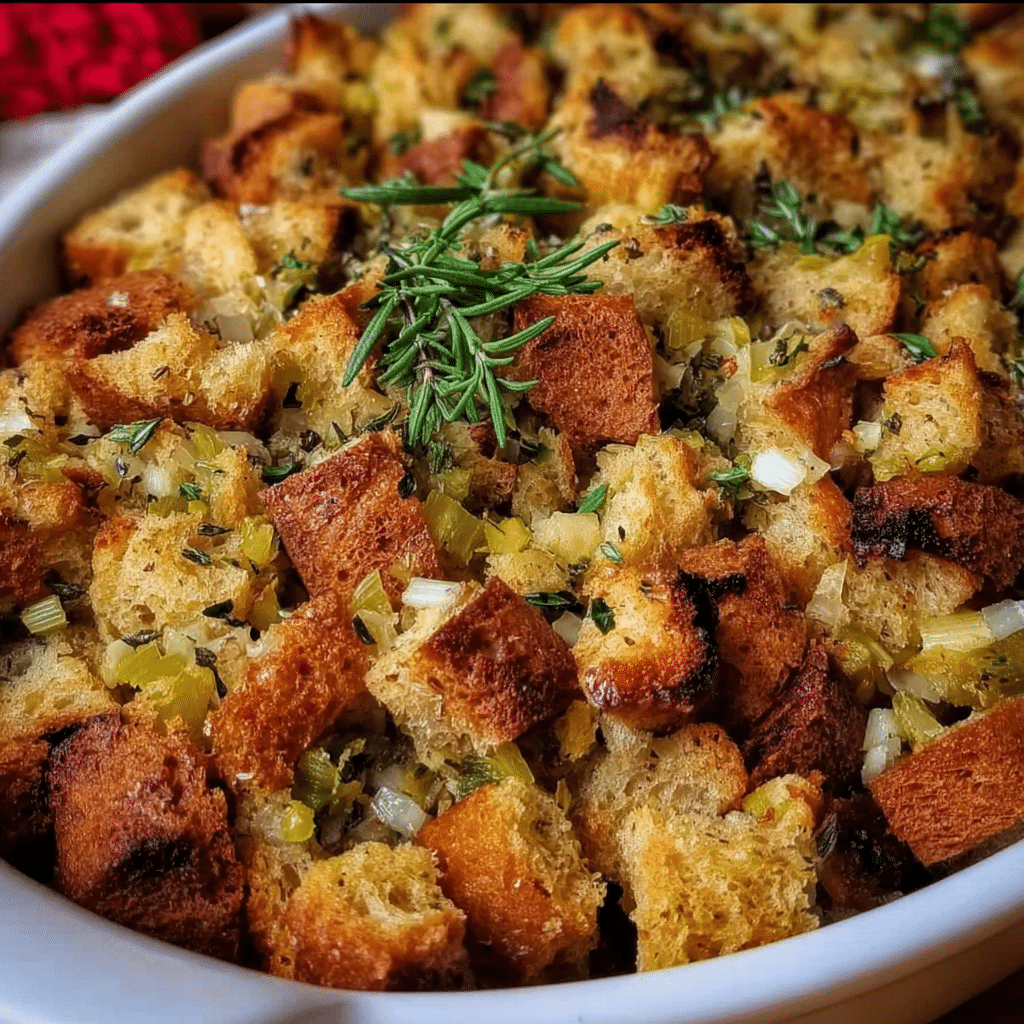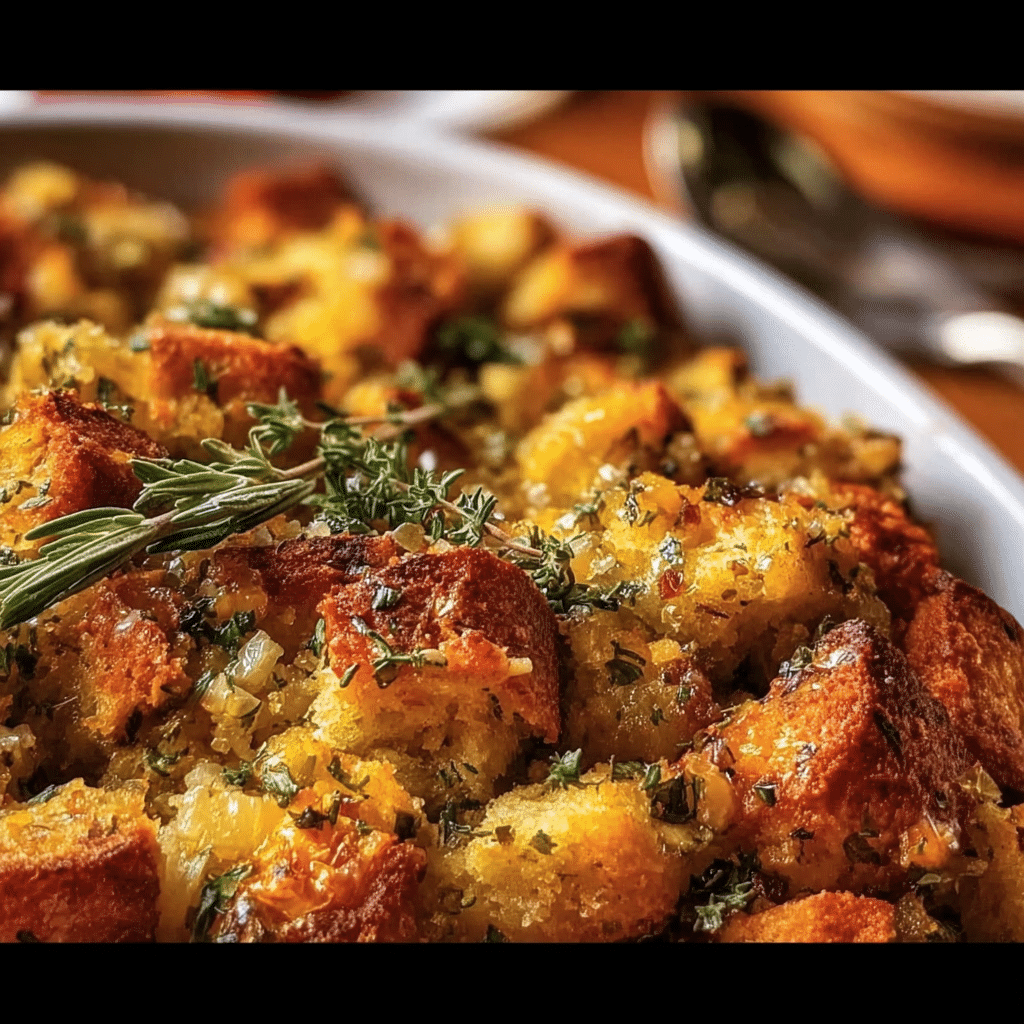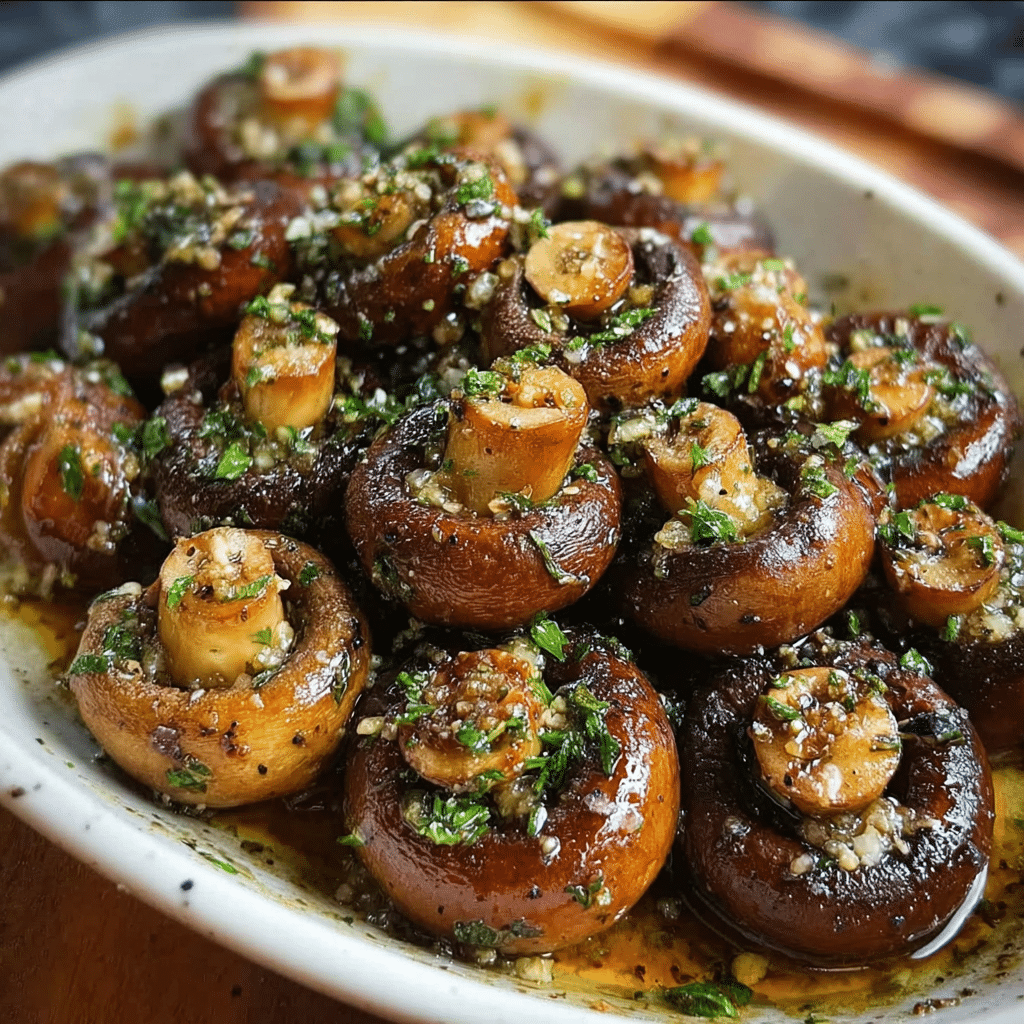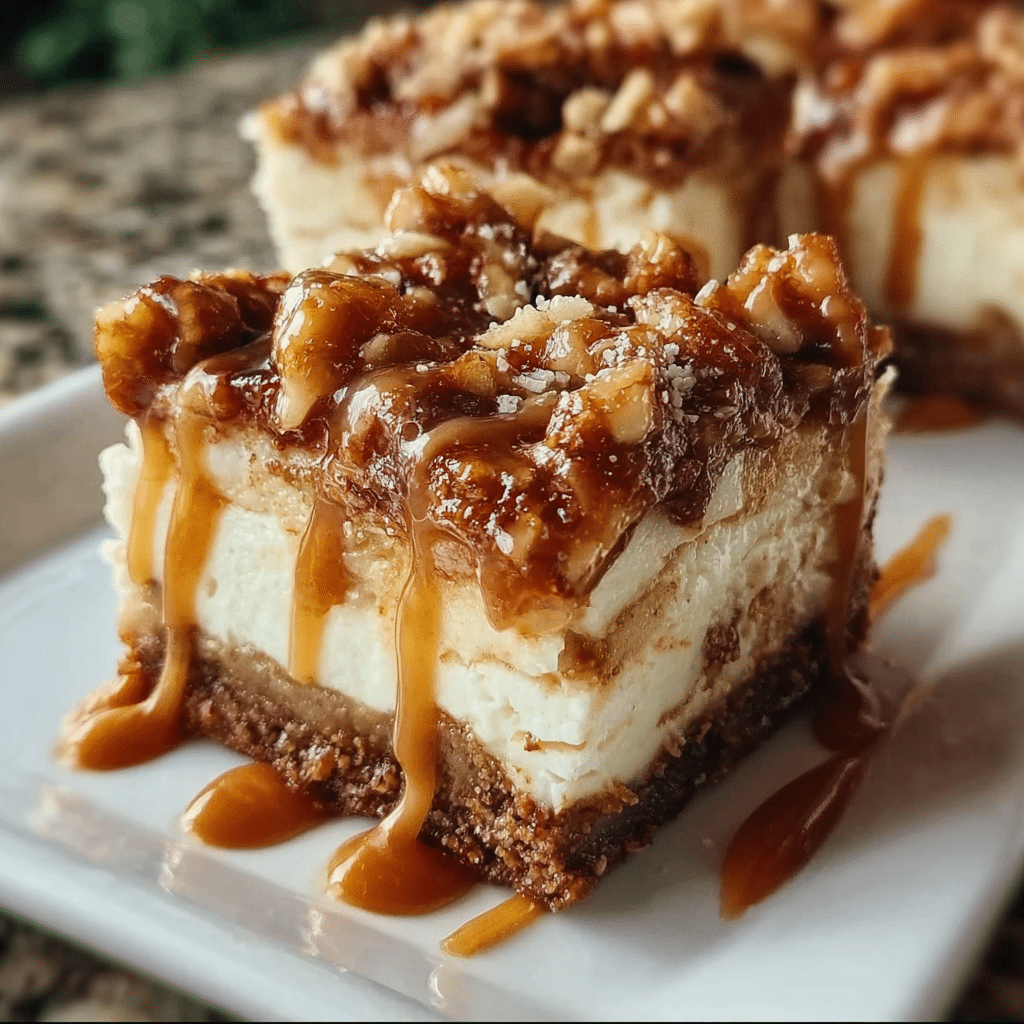Stove top stuffing has become a beloved staple in many households, often filling the air with a warm, inviting aroma that beckons family members to gather around the dinner table. My journey with this delightful dish began on a chilly autumn evening when my mother decided to whip up her famous stove top stuffing chicken casserole. As she stirred the savory mixture and layered it with tender chicken, I could feel the excitement bubbling within me. This was not just a meal; it was a cherished tradition, a comforting embrace that would nourish both body and soul.
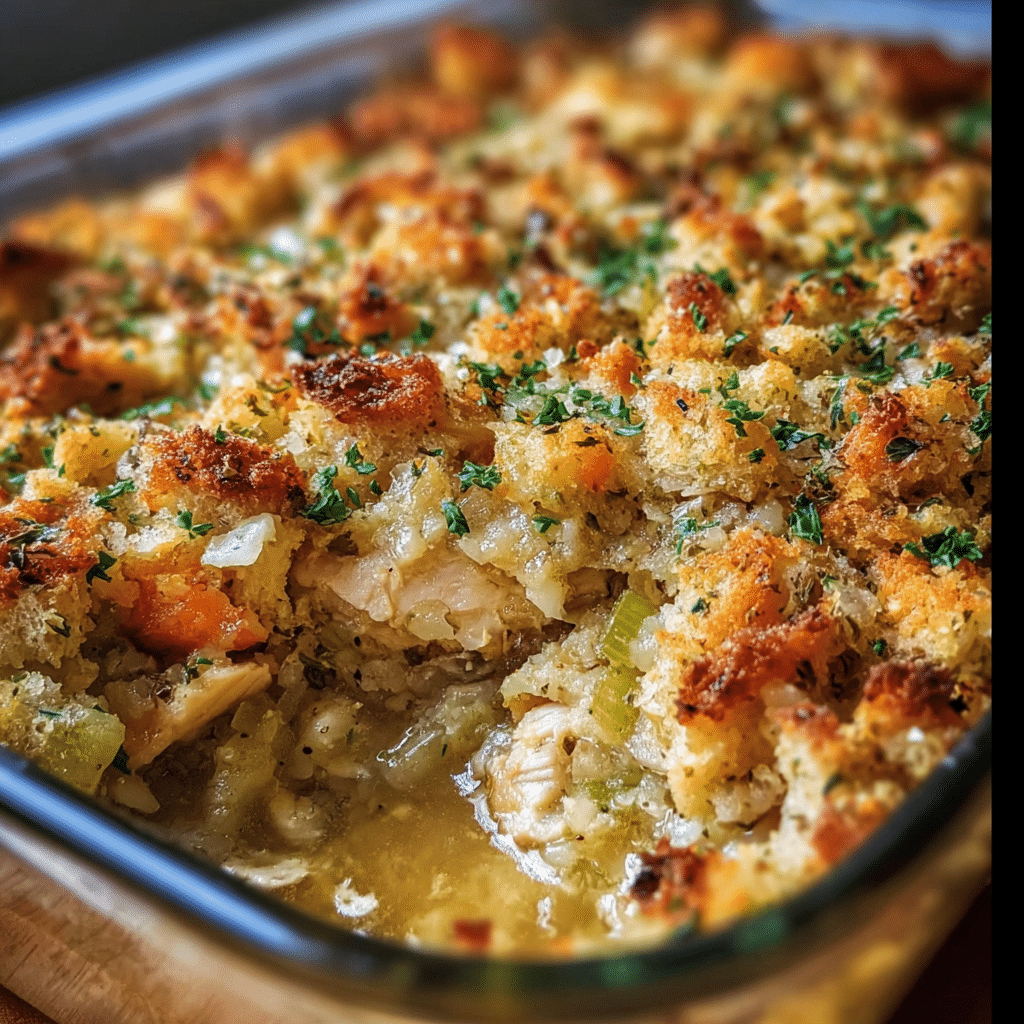
The Story Behind This Recipe
Growing up, my family always had a knack for making simple ingredients shine, and stove top stuffing was no exception. As my mother mixed the flavorful stuffing with cream of chicken soup and topped it with crispy, golden-brown chicken, I watched in awe. The simplicity of the ingredients belied the depth of flavor that came together in every bite. I remember eagerly waiting for the casserole to come out of the oven, the tantalizing scent wafting through the house. When it finally did, my family would gather around the table, each of us vying for the first helping, eager to dive into this delicious meal.
What makes stove top stuffing chicken casserole so special is its ability to transform a few basic ingredients into something magical. The combination of stove top stuffing, chicken, and a creamy sauce creates layers of flavor that dance on your palate. It’s a dish that speaks to the heart of home cooking—simple, satisfying, and always a crowd-pleaser. For busy families, this recipe is a golden ticket to a delicious dinner without hours spent in the kitchen. With just a few minutes of prep and a quick bake in the oven, you can serve a hearty meal that everyone will love.
This dish is particularly relevant during the fall and winter months when comfort food becomes a priority. As the weather turns chilly, there’s nothing quite like the warmth of a freshly baked chicken casserole to make you feel cozy. It’s perfect for family gatherings, weeknight dinners, or even potlucks, where you can share the love of home-cooked food with friends. The emotional connection to stove top stuffing is profound; it’s not just about the meal but the memories created around the table with loved ones.
In this article, you’ll learn how to recreate this nostalgic dish in your own home, as well as tips for making it your own. We’ll explore variations, cooking techniques, and even delve into the cultural significance of this beloved casserole. Whether you’re a novice cook or a seasoned chef, I promise you’ll find valuable insights that will elevate your cooking experience. Together, we’ll embark on a culinary journey that celebrates the heartwarming magic of stove top stuffing.
Why You’ll Love This Dish
Stove top stuffing chicken casserole is more than just a recipe; it’s a testament to the beauty of home-cooked meals that bring people together. The ease of preparation combined with the delicious outcome makes it a winner in any kitchen. You can customize it with your favorite vegetables, spices, or even different proteins, allowing for endless possibilities. Plus, it’s a fantastic way to use up leftover chicken or turkey, making it both economical and resourceful.
So, whether you’re reminiscing about family dinners of your childhood or looking for a reliable meal that pleases everyone at the table, stove top stuffing chicken casserole is your answer. Let’s get cooking and create some delicious memories together!
The Rich History and Cultural Significance of stove top stuffing
The origins of stove top stuffing can be traced back to the ancient practice of stuffing meats with various ingredients to enhance flavor and preserve moisture. However, the specific product we know today as stove top stuffing was first introduced by General Foods in 1972. It quickly gained popularity due to its convenience and versatility, transforming the way families approached cooking. With busy schedules and the rise of dual-income households, stove top stuffing provided a quick and easy solution for home-cooked meals.
Origins and History
The concept of stuffing dates back centuries, with various cultures around the world employing different methods to stuff meats with grains, vegetables, and spices. In the United States, stuffing has been a traditional part of holiday meals, particularly at Thanksgiving, where it is often made from bread, herbs, and spices. The introduction of dry stuffing mixes like stove top stuffing revolutionized this practice, making it accessible to everyone regardless of cooking skill.
Over time, the use of stove top stuffing has expanded beyond just stuffing birds. Home cooks have embraced it as a base for casseroles, side dishes, and even as a topping for baked meats. The flexibility of this product has allowed it to evolve into a pantry staple for many families, offering an easy way to add flavor and texture to a variety of dishes.
Cultural Significance
Stove top stuffing chicken casserole has found its place in American culture as a beloved comfort food. It is often seen at family gatherings, potluck dinners, and holiday feasts. The dish represents a blend of nostalgia and practicality, embodying the essence of home cooking. Many families have their own variations of the casserole, often passed down through generations, each adding a personal touch that makes it uniquely theirs.
This dish holds significant cultural relevance, particularly within families that value togetherness and shared meals. It symbolizes the love and care that goes into preparing food for loved ones, and the memories created around the dining table. It’s a dish that can easily adapt to seasonal ingredients, making it a year-round favorite for busy families seeking quick yet satisfying meal solutions.
Nutritional Benefits
While stove top stuffing chicken casserole is often regarded as comfort food, it can also be made with health in mind. The base of the dish—stove top stuffing—can be enhanced with nutritious ingredients such as vegetables, lean proteins, and low-fat dairy options. Incorporating vegetables like broccoli, carrots, or spinach not only adds color and flavor but also boosts the nutritional profile of the meal.
Additionally, using lean cuts of chicken or even turkey can provide a healthier alternative while still delivering that comforting taste we all love. Some families opt for whole grain stove top stuffing varieties, adding fiber and nutrients to the dish. Overall, with a few mindful adjustments, this casserole can be both indulgent and nutritious, making it a well-rounded choice for family dinners.
As we delve deeper into the world of stove top stuffing, you’ll discover the endless possibilities this beloved dish offers. From its rich history to its cultural significance and nutritional benefits, stove top stuffing chicken casserole is a dish that truly embodies the spirit of home cooking. So, let’s explore the many ways you can make this dish your own and create lasting memories in your kitchen!
Essential Ingredients for Perfect stove top stuffing
When it comes to creating a delicious and comforting dish, the right ingredients can make all the difference. This Stove Top Stuffing Chicken Casserole is a perfect example of how simple, quality ingredients can come together to create a hearty meal that warms the heart and soul. Let’s dive into each essential component that makes this casserole not only tasty but also a family favorite.
Essential Ingredients
- 2 pounds chicken tenderloins
- ½ teaspoon kosher salt
- ½ teaspoon black pepper
- 10.5 ounce can cream of celery soup
- 10.5 ounce can cream of chicken soup
- ¼ cup milk
- 6 ounce box Stove Top chicken stuffing mix
- 1 ½ cups chicken broth
- Fresh or dried parsley for garnish (optional)

Stove Top Stuffing Chicken Casserole
Ingredients
- 2 pounds chicken tenderloins
- ½ teaspoon kosher salt
- ½ teaspoon black pepper
- 10.5 ounce can cream of celery soup
- 10.5 ounce can cream of chicken soup
- ¼ cup milk
- 6 ounce box Stove Top chicken stuffing mix
- 1 ½ cups chicken broth (see notes below)
- fresh or dried parsley for garnish (optional)
Instructions
- Preheat the oven to 375°F. Spray an 11×7-inch baking dish with cooking spray, and set aside.
- Cut 2 pounds chicken tenderloins into bite-sized pieces and place them into the baking dish.
- Toss the chicken pieces with 1/2 teaspoon kosher salt and 1/2 teaspoon black pepper.
- In a small bowl, whisk together 10.5 ounce can cream of celery soup, 10.5 ounce can cream of chicken soup and 1/4 cup milk until smooth.
- Pour the sauce over the chicken pieces and smooth it out, so all of the chicken is covered.
- Evenly sprinkle the 6 ounce box Stove Top chicken stuffing mix on top.
-
Pour 1 1/2 cups chicken broth on top of the stuffing mix, and make sure that all of the stuffing is moistened by the broth.
-
Cover with foil and bake for about 40-45 minutes. Take the foil off and bake for an additional 5 minutes to lightly brown the top. NOTE: Oven times can vary for many reasons. It may take longer or be quicker in your particular oven. The chicken is done when the internal temperature reaches 165F degrees.
-
Garnish with fresh or dried parsley (optional) and serve. When serving, scoop up some of the gravy at the bottom and drizzle it over each serving.
Let’s explore each ingredient more closely to understand their roles and why they are so important in achieving the perfect Stove Top Stuffing experience.
Starting with the 2 pounds of chicken tenderloins, these are the star of our casserole. Tenderloins are chosen for their quick cooking time and tender texture, making them perfect for busy weeknights. When selecting chicken, look for tenderloins that are pink and free from any unpleasant odors. Organic chicken can be a great choice as it is often raised without antibiotics, and the flavor tends to be richer.
The ½ teaspoon kosher salt and ½ teaspoon black pepper are fundamental for seasoning. Kosher salt is preferred for its larger grain size, which makes it easier to control the seasoning without making the dish overly salty. Freshly cracked black pepper adds a depth of flavor that is essential in balancing the creaminess of the soups and the stuffing. Always opt for high-quality salt and pepper, as they can significantly impact the flavor profile.
Next up are the 10.5 ounce cans of cream of celery soup and cream of chicken soup. These soups serve as a creamy base that binds everything together while adding flavor. They also contribute to the overall texture of the casserole. When shopping, you may find reduced-fat versions, but I recommend sticking with the full-fat varieties for a creamier consistency. If you prefer to make your own, there are plenty of recipes online that can guide you through preparing homemade cream soups, which can be even more flavorful.
The ¼ cup milk is added to enhance creaminess and ensure the stuffing mix stays moist. Whole milk is recommended for richness, but if you’re looking for a lighter option, you can use low-fat or non-dairy alternatives. Just be cautious with non-dairy options, as some can alter the flavor.
The 6-ounce box of Stove Top chicken stuffing mix is what ties this entire dish together. This pre-packaged stuffing mix is beloved for its convenience and flavor. When purchasing, check the expiration date to ensure freshness. If you are keen on making your own stuffing mix, consider using dried bread, herbs, and spices for a homemade touch.
Next, we have 1 ½ cups of chicken broth, which adds moisture and flavor to the dish. Homemade broth is always a superior option if you have time, but store-bought can work in a pinch. Look for low-sodium versions to control the salt content of your meal. It’s always a good practice to taste your broth before adding it to your casserole, as some brands can be quite salty.
Lastly, we have fresh or dried parsley for garnish. While optional, it adds a pop of color and freshness to the dish. If you’re using fresh parsley, look for vibrant green leaves without any wilting, as this indicates freshness. Dried parsley can also work, but fresh is always a better choice for its flavor and visual appeal.
Shopping Tips
When it comes to shopping for these ingredients, I highly recommend visiting local farmers’ markets for fresh produce and organic options, especially for the chicken and herbs. Not only does this support local farmers, but you often find fresher and tastier products compared to grocery stores. For canned goods, stock up during sales, as they have long shelf lives and can save you money in the long run.
For the stuffing mix, consider buying in bulk if you make casserole dishes often. Many stores offer bulk bins where you can purchase only what you need, minimizing waste.
Substitutions and Alternatives
In the world of cooking, substitutions can be a lifesaver, especially for those with dietary restrictions. For instance, if you are looking for a gluten-free option, you can find gluten-free stuffing mixes available on the market. Additionally, if you want to cut down on calories, you can replace the cream soups with a homemade version that uses low-fat milk and a thickening agent like cornstarch.
If you are vegetarian, consider swapping the chicken tenderloins for a meat alternative such as tofu or chickpeas, and use vegetable broth instead of chicken broth. The flavor profile will change, but the dish can still be delicious and satisfying.
As for storage, most of these ingredients can be stored in a cool, dry place. Canned soups and stuffing mix can last for a long time, while fresh chicken should be cooked or frozen within a couple of days after purchase. Always label your frozen items with dates to keep track of freshness.
In conclusion, assembling the right ingredients for your Stove Top Stuffing Chicken Casserole is crucial to achieving a delightful and comforting meal. By understanding the role of each ingredient and how to select the best quality, you can create a dish that not only nourishes but also brings joy to the table.
Detailed Step-by-Step stove top stuffing Cooking Instructions
Now that we’ve gathered our essential ingredients for the Stove Top Stuffing Chicken Casserole, it’s time to roll up our sleeves and dive into the cooking process. Follow these detailed steps to create a mouthwatering casserole that your family will love.
Preparation Steps
Before we get started with the cooking, let’s prepare our workspace. The concept of mise en place, which means “everything in its place,” is crucial in any kitchen. This ensures that you have all your ingredients ready to go, making the cooking process smoother and more enjoyable.
- Preheat your oven to 350°F (175°C). This is important because you want your casserole to bake evenly and thoroughly.
- Prepare the chicken: Rinse the chicken tenderloins under cold water and pat them dry with paper towels. This not only helps with seasoning but also prevents excess moisture from affecting the texture.
- Season the chicken: In a large bowl, toss the chicken tenderloins with ½ teaspoon kosher salt and ½ teaspoon black pepper. This seasoning will enhance the chicken’s flavor as it cooks.
- Open the soup cans: Have the cream of celery soup and cream of chicken soup ready. You can mix them in a separate bowl if you prefer a more blended texture.
- Measure the chicken broth: Have 1 ½ cups of chicken broth ready to pour in later. This will be a key ingredient for adding moisture to the casserole.
- Gather your baking dish: Choose a 9×13 inch baking dish or a similar size, and lightly grease it with cooking spray or butter to ensure the casserole doesn’t stick.
Cooking Process
With our ingredients prepped and our workspace organized, let’s move on to the cooking process. This is where the magic happens!
- Cook the chicken: In a large skillet over medium heat, add a little oil and cook the seasoned chicken tenderloins for about 5-7 minutes on each side, or until they are golden brown and cooked through. Use a meat thermometer to check that the internal temperature has reached 165°F (75°C) to ensure food safety.
- Prepare the stuffing: While the chicken is cooking, in a separate bowl, combine the Stove Top chicken stuffing mix with the chicken broth and ¼ cup milk. Stir until well combined and let it sit for about 5 minutes. This will allow the stuffing to absorb the liquid.
- Mix the soups: In a large mixing bowl, combine the cream of celery soup and cream of chicken soup. If you want a creamier texture, consider whisking in an additional splash of milk.
- Combine the chicken and soup mixture: Once the chicken is cooked, remove it from the skillet and cut it into bite-sized pieces. Add the chicken pieces to the bowl with the soup mixture, combining it until the chicken is evenly coated.
Final Assembly
Now we’re nearing the finish line! It’s time to assemble our casserole for baking.
- Layer the chicken and soup mixture: Pour the chicken and soup mixture into the greased baking dish, spreading it evenly across the bottom.
- Add the stuffing: Spoon the prepared stuffing mixture over the chicken layer, spreading it evenly to cover the entire surface. Gently press down to ensure it combines well with the chicken mixture.
- Bake the casserole: Place the baking dish in the preheated oven and bake for about 30 minutes. The casserole is done when it is bubbly and the top is golden brown. You can also check that the center is heated through by inserting a knife or fork.
- Garnish: Once out of the oven, sprinkle some fresh or dried parsley on top for a pop of color and flavor.
- Serve: Allow the casserole to sit for about 5-10 minutes before serving. This resting time helps the layers set slightly, making it easier to serve.
Common mistakes to avoid include overcooking the chicken initially, which can result in dry meat, and neglecting to let the casserole sit before serving, causing it to fall apart on the plate. Remember that patience is key, and with each step, you’re building layers of flavor that will delight everyone at the dinner table.
In conclusion, making Stove Top Stuffing Chicken Casserole is not just about following a recipe; it’s about creating a dish that brings warmth and comfort to your home. By following these detailed instructions, you will not only master the art of the casserole but also create cherished memories with those you love. Happy cooking!
Professional Tips and Techniques for stove top stuffing
When it comes to making a delicious Stove Top Stuffing Chicken Casserole, there’s more than meets the eye. While the name might suggest a simple dish, the secret to elevating it lies in mastering professional cooking techniques and understanding the nuances of ingredients. As someone who has spent countless evenings experimenting in the kitchen, I can attest that the magic often lies in the details. Here, I’ll share some insider tips and techniques that will not only enhance your casserole but also boost your confidence in the kitchen.
Professional Techniques
First things first, let’s talk about the stove top stuffing itself. This pre-packaged product is a time-saver, but you can turn it into something extraordinary with the right techniques. A personal favorite of mine is to enhance the flavor of the liquid used for preparing the stuffing. Instead of just water, try using chicken broth or stock. This simple swap adds depth and richness to your base. If you’re feeling adventurous, consider adding a splash of white wine to the broth for added complexity.
Next, think about layering your ingredients. The beauty of a casserole is in its ability to meld flavors together, but the order in which you layer can impact the final dish. Start with a layer of your cooked chicken, seasoned well with salt and pepper. Then, spread your stove top stuffing mixture evenly over the chicken. On top of that, consider adding a layer of vegetables, such as sautéed mushrooms or spinach, which not only adds nutrition but also brings color and texture to your casserole.
For a crispy topping, mix some breadcrumbs or crushed crackers with melted butter and sprinkle it over the top before baking. This step can make a world of difference, creating a delightful contrast between the creamy interior and the crunchy exterior.
Troubleshooting Guide
Even the most experienced cooks encounter challenges, so let’s address some common problems you might face when preparing your stove top stuffing casserole. One frequent issue is dryness. If your casserole turns out too dry, consider adding more liquid next time—either broth or a bit of cream. Additionally, cover the casserole with foil during the initial baking stage to retain moisture, removing it towards the end to allow for browning.
If your stuffing feels mushy, it may be that you added too much liquid during preparation. Always start with the recommended liquid amount on the packaging, and adjust as needed based on your personal preference. Remember, you can always add more, but it’s hard to take it out!
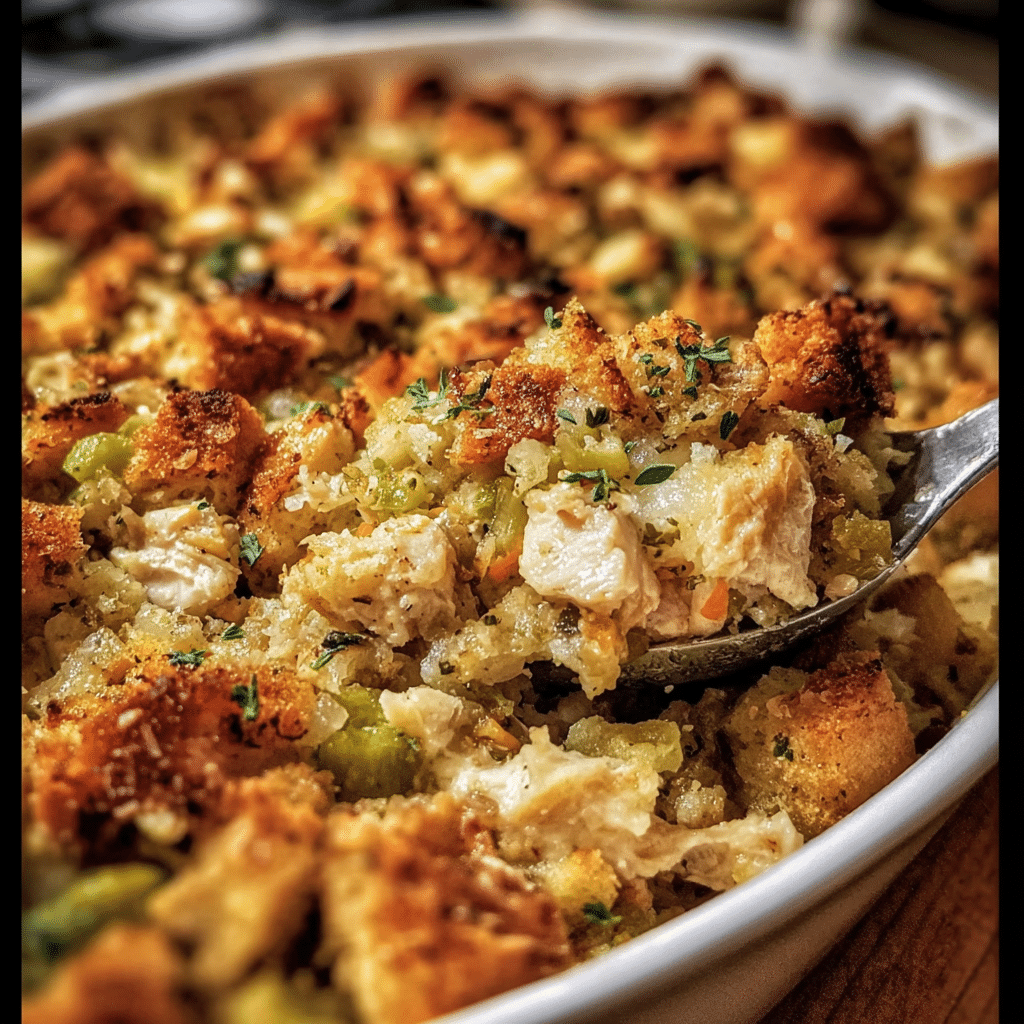
Presentation Tips
Presentation is key when serving any dish, and your Stove Top Stuffing Chicken Casserole deserves to shine. I always recommend using a beautiful ceramic or glass dish that can go from oven to table. Once your casserole is baked and golden brown, let it rest for about 10 minutes before serving. This resting time allows the flavors to settle and makes serving easier.
For an appealing presentation, garnish with fresh herbs such as parsley or thyme. This not only adds a pop of color but also a fresh aroma that will entice your guests. Serve it alongside a crisp green salad or roasted vegetables to create a well-rounded meal.
As for beverage pairings, a chilled glass of Chardonnay or a light-bodied Pinot Noir complements the flavors of the casserole beautifully. The acidity in these wines balances the richness of the dish, making for an enjoyable dining experience.
In terms of meal prep, consider making your casserole in advance. You can prepare it a day ahead, cover it tightly, and store it in the refrigerator. When ready to bake, simply remove it from the fridge and add a few extra minutes to your cooking time. This is a lifesaver on busy weeknights or when hosting guests. You can focus on enjoying their company rather than stressing over dinner!
Scaling your recipe is also straightforward. If you need to feed a crowd, simply double the ingredients and use a larger dish. Just be mindful to increase the cooking time slightly, as a larger quantity may require a bit more time to bake thoroughly.
In summary, mastering the art of making a stove top stuffing casserole involves understanding the flavors and textures you want to achieve. With these professional tips and techniques in hand, you’ll not only create a delicious dish but also build confidence in your cooking abilities.
Creative Variations and Adaptations of stove top stuffing
Stove Top Stuffing Chicken Casserole is a versatile dish that can be customized in countless ways. It’s like a blank canvas for your culinary creativity! Over the years, I’ve experimented with various ingredients and techniques, which has led to some exciting adaptations that cater to different tastes and dietary needs. Let’s dive into some creative variations and adaptations that you can easily try at home.
Seasonal Variations
One of the joys of cooking with stove top stuffing is that it can be adapted for any season. In the fall, consider incorporating seasonal vegetables like roasted butternut squash or Brussels sprouts, adding a touch of sweetness and heartiness to your casserole. For a winter twist, think about using a creamy mushroom soup instead of broth, alongside sautéed leeks for a warming, cozy flavor profile.
In spring, fresh herbs and vegetables can lighten up your dish. Try adding asparagus and peas, along with a hint of lemon zest for brightness. During the summer, grilled chicken paired with fresh garden tomatoes and zucchini can make your casserole feel light and refreshing. The beauty of stove top stuffing is how it harmonizes with various flavors, making it an excellent base for seasonal ingredients.
Dietary Adaptations
If you’re catering to dietary restrictions, there are plenty of options to modify your stove top stuffing casserole without sacrificing flavor. For a keto-friendly version, swap out the stove top stuffing for riced cauliflower. You can sauté the cauliflower with onions and garlic, then layer it with cheese and chicken for a low-carb delight.
For a vegan adaptation, use plant-based chicken substitutes and replace the stove top stuffing with a mix of quinoa and sautéed vegetables. Use vegetable broth to prepare the stuffing mixture and add nutritional yeast for a cheesy flavor. These changes will ensure that everyone can enjoy this comforting dish, regardless of dietary needs.
Creative Twists
One of the most fun aspects of cooking is experimenting! Why not take a trip around the world with your stove top stuffing casserole? Inspired by Mexican cuisine, you could incorporate black beans, corn, and diced tomatoes into the mix, topped with a sprinkle of taco seasoning. Serve it with avocado slices and a dollop of sour cream for a delightful twist.
For an Italian flair, consider adding marinara sauce, spinach, and mozzarella cheese. This variation turns your casserole into a comforting lasagna-like dish that is sure to please the whole family. Another option is to go Asian-inspired by using soy sauce, ginger, and sesame oil, along with cooked chicken and stir-fried vegetables. It’s a great way to infuse different flavors while keeping the essence of the beloved stove top stuffing.
Don’t forget about leftovers! If you have any casserole left, transform it into a delicious sandwich. Layer it between two slices of crusty bread with some fresh greens and a dollop of mayo or mustard, creating a hearty lunch option. Alternatively, you could repurpose leftover casserole as a filling for stuffed bell peppers, baking them until perfectly tender.
In conclusion, the possibilities with stove top stuffing chicken casserole are endless. Whether you’re adapting to seasonal ingredients, catering to dietary preferences, or simply looking to try something new, this dish can be a reflection of your personal taste and creativity. So, roll up your sleeves, gather your ingredients, and let your imagination run wild in the kitchen!
Storage, Reheating, and Meal Prep for stove top stuffing
When it comes to enjoying a delicious dish like stove top stuffing chicken casserole, understanding how to store, reheat, and meal prep this savory delight is just as important as mastering the recipe itself. After all, life gets busy, and having ready-to-eat meals can save time and reduce stress during the week. Let’s delve into everything you need to know about the storage of this beloved dish, ensuring that it stays just as scrumptious as when it came out of the oven.
Short-term Storage
For short-term storage, the refrigerator is your best friend. After you’ve savored your stove top stuffing chicken casserole, you’ll want to store any leftovers promptly to maintain quality and safety. Allow the casserole to cool at room temperature for no longer than two hours before transferring it to an airtight container. Make sure to use containers that are not too large—this minimizes the amount of air in the container and helps prevent spoilage. Glass containers with lids are ideal as they don’t absorb odors and are easy to clean.
Label your containers with the date, and try to consume your leftovers within 3-4 days. This is essential for food safety, as bacteria can grow rapidly in cooked foods left too long in the refrigerator. If you’re like me and sometimes forget what’s in the fridge, this labeling trick is a lifesaver!
Freezing and Long-term Storage
If you think you won’t be able to eat your delicious stove top stuffing chicken casserole within a few days, freezing is a fantastic option! Freezing not only preserves the dish but can also make for an easy meal on a busy day. To freeze, let the casserole cool completely, then portion it into freezer-safe containers or heavy-duty freezer bags. If using bags, remove as much air as possible to prevent freezer burn.
When properly stored, your casserole can last up to three months in the freezer. However, for the best taste and texture, aim to enjoy it within a month. When freezing, consider portioning out individual servings. This way, you can simply grab a single serving for lunch or dinner without having to thaw the entire casserole.
Before freezing, it’s wise to consider the texture of your casserole. Ingredients like cream or certain vegetables may not freeze well and can alter the dish’s final texture upon reheating. If you’re using a lot of creamy elements, you might want to freeze the stuffing separately from the chicken and sauce.
Reheating Best Practices
When it’s time to enjoy those leftovers, reheating your stove top stuffing chicken casserole properly is key to preserving flavor and texture. The microwave is convenient, but I prefer using an oven or toaster oven for optimal results. Preheat your oven to 350°F (175°C) and place the casserole in an oven-safe dish. If it seems a bit dry, consider adding a splash of chicken broth or water to help revive its moisture. Cover the dish with aluminum foil to prevent it from drying out, and heat for about 25-30 minutes, or until it’s heated through.
If you’re reheating from the freezer, it’s best to thaw it in the fridge overnight before reheating. This gradual thawing helps maintain the quality of the dish. If you’re in a rush, you can reheat from frozen, but expect it to take longer—around 45-60 minutes in the oven.
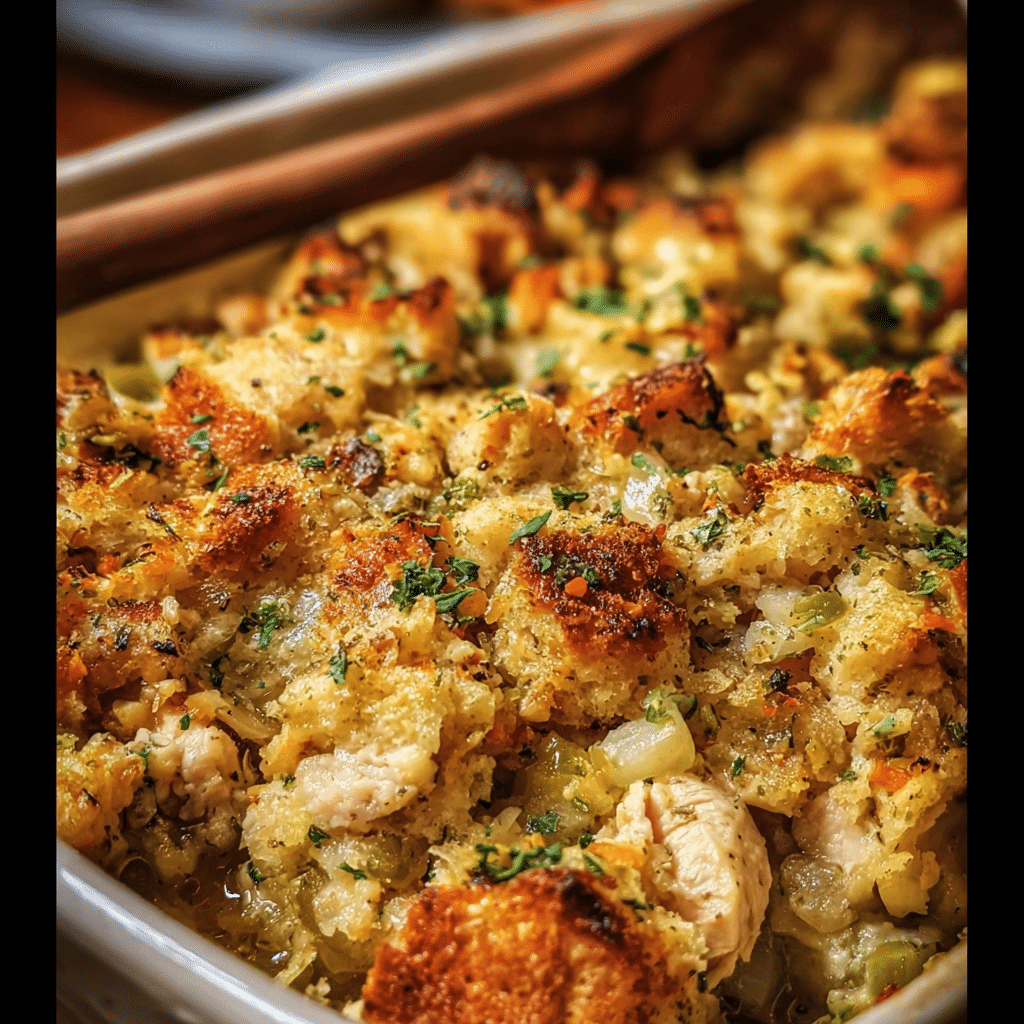
Food safety is paramount, so ensure the casserole is heated to an internal temperature of 165°F (74°C) before serving. Using a food thermometer can take the guesswork out of this step, ensuring you enjoy your meal without any worries.
Finally, if you’re meal prepping for the week, consider cooking a larger batch of stove top stuffing chicken casserole to enjoy throughout the week. Portion it out into smaller containers, and you’ll have a quick and satisfying meal ready to go at a moment’s notice. This not only saves time but also helps with portion control, keeping your meals consistent and balanced.
With these storage, freezing, and reheating tips, you can enjoy your stove top stuffing chicken casserole for days to come, making it a practical choice for delicious meals. Whether it’s a busy weeknight dinner or a make-ahead meal for guests, mastering the art of storage will ensure that your casserole remains as delightful the second time around as it was when you first made it.
Nutritional Benefits and Health Information
As we dive into the nutritional benefits and health information surrounding the beloved stove top stuffing chicken casserole, it’s essential to recognize that food can be both delicious and nutritious. This dish, often a staple at family gatherings and holiday dinners, contains a blend of ingredients that can provide a variety of vitamins and minerals, alongside comfort and satisfaction. Let’s explore the nutritional profile, health benefits, and dietary considerations that come with this casserole.
Nutritional Profile
The primary components of a stove top stuffing chicken casserole typically include chicken, stove top stuffing mix, vegetables, and sometimes cream of chicken soup or other sauces. On average, a one-cup serving of this casserole can contain around 300-400 calories, depending on the specific ingredients used and the portion size. Here’s a basic breakdown:
- Calories: 300-400
- Protein: 20-25g (primarily from the chicken)
- Fat: 10-15g (varies based on added sauces)
- Carbohydrates: 30-40g (mainly from the stuffing mix and vegetables)
- Fiber: 2-4g (depending on the vegetables used)
These values can fluctuate based on the specific brands and types of ingredients you choose, but it’s a good general guideline to start with. The inclusion of chicken ensures a solid protein source, which is crucial for muscle repair and overall bodily function.
Health Benefits
There are several health benefits to be gained from the key ingredients in a stove top stuffing chicken casserole. For one, the chicken serves as an excellent source of lean protein, which is vital for muscle development and repair. It also contains B vitamins, which are essential for energy metabolism and brain health.
The stuffing mix, typically made from bread crumbs, herbs, and spices, can provide carbohydrates that serve as a source of energy. Additionally, many people add vegetables to their casserole, which can significantly boost its nutritional value. Vegetables like peas, carrots, or green beans contribute essential vitamins and minerals, such as vitamin A, vitamin C, and potassium, all of which support immune function and overall health.
Moreover, if you opt for whole grain stuffing mixes, you’ll gain additional fiber, which is beneficial for digestive health and can help in maintaining a healthy weight. Fiber aids in feeling full longer, reducing the temptation to snack excessively.
Dietary Considerations
When preparing your stove top stuffing chicken casserole, it’s important to consider any dietary restrictions or allergens. Common allergens in this dish could include gluten (found in traditional stuffing mixes) and dairy (if using cream-based soups). For those with gluten sensitivity, there are gluten-free stuffing mixes available that can be substituted without sacrificing flavor.
For individuals who are lactose intolerant or looking to reduce dairy intake, alternatives such as almond milk or dairy-free cream soups can be used to maintain creaminess without the lactose. Additionally, vegetarians can easily adapt this recipe by using vegetable broth instead of chicken broth and substituting chicken with high-protein plant sources, such as tofu or chickpeas.
In terms of calorie content, if you’re monitoring your intake, consider using a reduced-fat cream soup or even making your own sauce with less fat. This way, you can still enjoy the comforting flavors of the casserole while keeping it lighter.
Overall, the stove top stuffing chicken casserole can fit into various diet plans, whether they be low-carb, high-protein, or even vegetarian with a few modifications. The key is to balance the ingredients according to your personal health goals.
In conclusion, this casserole is more than just a comfort food dish; it also offers a variety of nutritional benefits that can contribute positively to your health when prepared mindfully. By understanding its ingredients and making thoughtful choices, you can enjoy a satisfying meal that aligns with your dietary needs and preferences, ensuring that both your taste buds and your body are happy!
Frequently Asked Questions About Stove Top Stuffing
Old fashioned stove top stuffing chicken casserole
Old fashioned stove top stuffing chicken casserole is a comforting dish that combines tender chicken with flavorful stuffing. To make this casserole, start by cooking your chicken until it’s fully done, then shred it into bite-sized pieces. Mix the chicken with prepared Stove Top stuffing, chicken broth, and your choice of seasonings to enhance the flavor. Bake the mixture in a casserole dish at 350°F for about 30 minutes, or until heated through and slightly crispy on top. For added depth, consider incorporating sautéed onions and celery into the stuffing mixture for that classic homemade taste.
4 Ingredient chicken and stuffing casserole
This simple 4-ingredient chicken and stuffing casserole is perfect for a quick weeknight meal. You’ll need cooked chicken, a box of Stove Top stuffing, cream of chicken soup, and chicken broth. Begin by mixing the shredded chicken with the cream of chicken soup and some chicken broth until well combined. Stir in the prepared stuffing mix, then pour the entire mixture into a greased casserole dish. Bake at 350°F for about 30 minutes, or until the casserole is bubbly and the stuffing is golden brown. This dish is not only easy to prepare but also incredibly satisfying!
Pioneer Woman chicken Stuffing Casserole
The Pioneer Woman’s chicken stuffing casserole is a delicious twist on the classic recipe. To recreate her version, start with a base of cooked chicken, mixing in sautéed vegetables like onions, carrots, and celery for added flavor. Combine this mixture with Stove Top stuffing and chicken broth, and layer it in a greased baking dish. Bake at 375°F for about 35-40 minutes, allowing the flavors to meld and the top to achieve a crispy texture. Don’t forget to top it with shredded cheese in the last few minutes of baking for an extra cheesy finish!
Best stove top stuffing chicken casserole
The best stove top stuffing chicken casserole is one that balances flavors and textures perfectly. Start with high-quality ingredients: use fresh, cooked chicken and a flavorful broth. Enhance the stuffing by adding sautéed vegetables like mushrooms and bell peppers, which will add depth to the flavor profile. Bake at a moderate temperature, around 350°F, for about 30-40 minutes to ensure the stuffing is cooked through and has a nice crust. For an extra layer of taste, consider adding herbs like thyme or rosemary to your mixture.
Stove top stuffing chicken casserole with mixed vegetables
Incorporating mixed vegetables into your stove top stuffing chicken casserole is a great way to add nutrition and variety. Start by sautéing your choice of vegetables—such as peas, carrots, and corn—until slightly tender. Mix these veggies with the cooked chicken and prepared Stove Top stuffing, along with some chicken broth to keep the casserole moist. Bake the mixture at 350°F for about 30 minutes, or until the top is golden brown. This not only makes the dish heartier but also adds vibrant colors and textures!
Rotisserie chicken and Stove Top stuffing casserole
Using rotisserie chicken in your Stove Top stuffing casserole is a fantastic time-saver and adds incredible flavor. Shred the rotisserie chicken and combine it with prepared stuffing, chicken broth, and any desired seasonings. You can also mix in additional ingredients like cream of mushroom soup or sautéed onions for extra creaminess and depth. Transfer the mixture to a greased casserole dish and bake at 350°F for about 25-30 minutes, until heated through and the top is slightly crispy. This dish is perfect for a quick dinner or as a potluck favorite!
Stove Top Stuffing chicken casserole with tomatoes
Adding tomatoes to your Stove Top stuffing chicken casserole can create a delightful flavor twist. Start by mixing cooked, shredded chicken with diced tomatoes (canned or fresh), and then combine with prepared Stove Top stuffing and chicken broth. For a zesty kick, consider adding Italian seasoning or a dash of hot sauce. Bake the casserole at 350°F for about 30-35 minutes until it is bubbly and the stuffing is golden. The tomatoes will keep the dish moist and add a refreshing contrast to the richness of the stuffing and chicken.
Stove Top chicken casserole with vegetables
Creating a Stove Top chicken casserole with vegetables is an excellent way to pack in nutrients while keeping it flavorful. Start by sautéing vegetables such as bell peppers, broccoli, and carrots until tender. In a large bowl, mix these vegetables with shredded cooked chicken, prepared Stove Top stuffing, and enough chicken broth to ensure the mixture is moist but not overly wet. Transfer everything to a greased casserole dish and bake at 350°F for about 30 minutes, or until the top is golden brown. This dish is not just delicious but also a complete meal in one!
Conclusion: Mastering the Perfect stove top stuffing
Creating the perfect stove top stuffing is more than just following a recipe—it’s about understanding the techniques, ingredients, and cultural significance behind this beloved dish. Throughout this comprehensive guide, we’ve explored everything from the historical origins to modern variations, ensuring you have all the knowledge needed to make this recipe your own.
Whether you’re a beginner cook or an experienced chef, the techniques and tips we’ve shared will help you create a stove top stuffing that’s not only delicious but also meaningful. Remember that cooking is a journey of discovery, and each time you make this dish, you’ll learn something new.
We encourage you to experiment with the variations we’ve discussed, adapt the recipe to your dietary needs, and most importantly, share it with the people you love. Food has the incredible power to bring people together, and Stove Top Stuffing Chicken Casserole is the perfect dish to create lasting memories around your dinner table.

